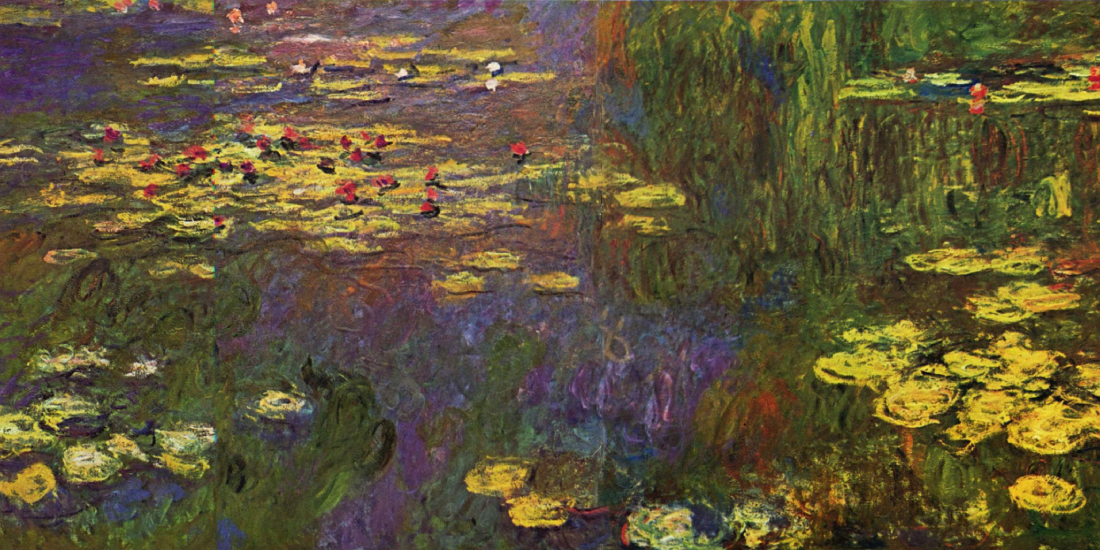
Water Lilies, evening effect by Monet: when nature becomes an emotional experience
Jayde BrowneShare
“Water Lilies, evening effect” by Claude Monet embodies a dreamlike, suspended vision where no human figure finds a place, leaving the water lilies, the reflections, and the ever-changing surface of the water as the absolute protagonists. In the work, the flowers float indistinctly, scattered across the mirror of the pond like points of color emerging from the depths without a precise geometric distribution.
The sky, sunset, and clouds merge with the reflective surface of the pond, making the boundary between water and air indistinguishable. The atmosphere is enveloping and almost mystical: Monet captures the evening calm, suspended between silence and vibration, transporting the viewer to a place where nature loses its concreteness and becomes an emotional experience.
BUY THE REPRODUCTION OF"WATER LILIES EVENING EFFECT" BY MONET
Style
The style of this work belongs fully to Impressionism, yet Monet, by then in his mature years, transcends simple visual impression and approaches a form of painting that is almost abstract. His brushstrokes are quick and spontaneous, appearing almost improvised but in fact the result of a profound compositional sensitivity, capable of conveying emotions rather than mere images.
Monet painted this work in the final years of his life, shortly before 1926, at a time when he challenged the limits of traditional painting and allowed himself to be influenced by the pursuit of luminosity, the science of color, and the technical innovations of his era. In the paintings from this series of water lilies, one perceives his desire to transform the canvas into a sensory medium, placing feelings and moods at the center of the visual narrative. The influence of Oriental, particularly Japanese, art can be discerned in the delicacy of the represented forms and in the decision to omit strict horizons or vanishing points.
Color and lighting
The color palette of Water Lilies, evening effect is dominated by purples, blues, emerald greens, and touches of pink and yellow, chosen to evoke the fading light of dusk. The reflections in the pond create a symphony of tones that oscillate between warm and cool colors: Monet employs pigments such as viridian (a deep green), cobalt violet (a brilliant chemically derived violet), and vermilion, all mixed directly on the canvas to produce vibrant and shifting nuances.
The interplay of light, sometimes radiant openings, sometimes areas of shadow, shimmers between the water lilies and the surface of the pond. Illumination is not confined to a defined physical space but helps dissolve the boundaries between the real environment and the realm of sensations. The tensions between complementary colors, such as red and green, highlight certain details and guide the viewer’s gaze through the work.
Spatial treatment
In this work, Monet allows the planes to overlap without traditional perspective. The water appears both as a reflective surface, mirroring the sky, clouds, and twilight colors, and as an ambiguous depth in which the lilies seem to float and sink simultaneously.
Depth is suggested more by chromatic variation and the succession of brushstrokes than by clear lines or volumes. In this way, Monet shifts attention away from optical illusion toward the fleeting, personal impression of nature, breaking with the logic of classical perspective. Everything in the composition seems to exist within a liquid, vibrant space where every detail communicates both movement and stillness, complicity between sky and water.
Composition and framing
The arrangement of elements in Water Lilies, evening effect reflects a search for balance distant from conventional rules: the shapes of the lilies are only faintly suggested, distributed irregularly, almost randomly, to simulate their natural drifting in the water.
There are no vanishing points, horizons, or perspectival lines; the scene is constructed from below, as if Monet had observed the pond from close proximity, immersing his gaze within it. Areas of color alternate, creating focal points where light refracts and chromatic contrasts emerge decisively. Overall harmony arises from the interplay between fullness and emptiness, from the dialogue between illuminated and shadowed surfaces, from the fluid and circular rhythm of the floating vegetation. The point of view is immersive, inviting the viewer to lose themselves in the painting as one would when gazing directly at nature, letting the mind wander among lights, reflections, and shadows.
Technique and materials
Monet painted Water Lilies, evening effect on canvas, using high-quality oil paints available in France between the late nineteenth and early twentieth century. Among the pigments employed are viridian, cobalt violet, and vermilion, each of which adds intensity and depth to the chosen tones while enlivening luminous variations and reflections.
The execution relies on the layering of rapid brushstrokes, sometimes dense, sometimes transparent, applied either onto wet paint to encourage blending of colors or onto dry layers to produce tactile effects and visible movement across the surface. Traces of the tools he used, such as brushes of various sizes and likely some palette knives, can be discerned in the variety of marks and in the vibrancy of the paint, which takes on a textural character, emphasizing the physicality of the artistic gesture without ever sacrificing the delicacy of nuance.
This choice of materials and methods allowed Monet to represent nature in an immediate and expressive way, transforming the canvas into a visual field where color, light, and rhythm become the absolute protagonists.

